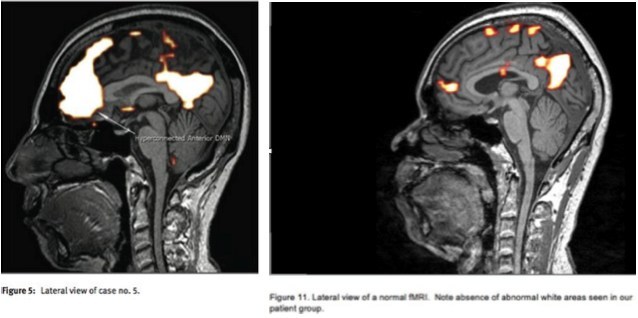Pilot Study Shows Dramatic Difference In Brain Activity With EHS With EHS (Electrohypersensitive) Cases As Compared To Controls (Non EHS).
Press Release
PRESS TELE-CONFERENCE, THURS., Dec. 7th, 12 NOON PST.
This is the first known published study to show pictures of EHS on an fMRI.
The Peoples Initiative Foundation
Dec 05, 2017, 09:37 ET
LOS ANGELES, Dec. 5, 2017 /PRNewswire/ — The Peoples Initiative Foundation has announced the conclusion of a pilot study they organized, headed up by Dr. Gunnar Heuser, showing EHS on an fMRI. This study was originally published by Degruyter in July of 2017, but was absent pictures of the controls. The company waited until the pictures were placed in the study to issue this press release, as the visual difference between the cases and controls is quite dramatic.

Below are 2 sample pictures from the study. The large white area on the left side of the left picture shows hyperconnectivity in the brain of a case (EHS person). The same small white area in the picture to the right shows normal brain activity in a control (non EHS person).
EHS or “electrohypersensitivity” in civilian terms, “microwave radiation poisoning” in military terms, is an RF (radio frequency) or microwave radiation induced illness who’s very existence is hotly debated by government and wireless industry scientists and personnel. This study provides evidence that abnormalities exist in the EHS brain that are not present in the non EHS brain and could put an end to the debate on the existence of EHS. It also defies the widely held governmental and wireless industry stance that wireless devices and infrastructure have no consequences to human health and could impact the prevailing opinion of wireless radiation being deemed safe.
The Peoples Initiative Foundation will be holding a tele-press conference to take questions from the media Thurs. Dec. 7th @ 12 noon PST. The study’s principle author, Dr. Gunnar Heuser will be on the call to take questions about the study, as well as Liz Barris, study organizer and one of the EHS cases in the study to take questions about EHS.
Journalists on deadline who RSVP by emailing: contact@thepeoplesinitiative.org with the # they will be calling in from will be given first priority in the tele-press conference queue.
Please call 515-739-1219 access code 283521#
Emergency back up # only in case above # has problem:
605-472-5616 access code 106520#
For free abstract and purchase of full text of the study with case pictures go here… https://www.degruyter.com/view/j/reveh.2017.32.issue-3/reveh-2017-0014/reveh-2017-0014.xml
Corrigendum and control pictures here…
https://www.degruyter.com/view/j/reveh.2017.32.issue-4/reveh-2017-0027/reveh-2017-0027.xml?format=INT
www.thepeoplesinitiative.org
contact@thepeoplesinitiative.org
310-281-9639
SOURCE The Peoples Initiative Foundation
Abstract
Abstract
INTRODUCTION:
Ten adult patients with electromagnetic hypersensitivity underwent functional magnetic resonance imaging (fMRI) brain scans. All scans were abnormal with abnormalities which were consistent and similar. It is proposed that fMRI brain scans be used as a diagnostic aid for determining whether or not a patient has electromagnetic hypersensitivity. Over the years we have seen an increasing number of patients who had developed multi system complaints after long term repeated exposure to electromagnetic fields (EMFs). These complaints included headaches, intermittent cognitive and memory problems, intermittent disorientation, and also sensitivity to EMF exposure. Regular laboratory tests were within normal limits in these patients. The patients refused to be exposed to radioactivity. This of course ruled out positron emission tomography (PET) and single-photon emission computed tomography (SPECT) brain scanning. This is why we ordered fMRI brain scans on these patients. We hoped that we could document objective abnormalities in these patients who had often been labeled as psychiatric cases.
MATERIALS AND METHODS:
Ten patients first underwent a regular magnetic resonance imaging (MRI) brain scan, using a 3 Tesla Siemens Verio MRI open system. A functional MRI study was then performed in the resting state using the following sequences: A three-dimensional, T1-weighted, gradient-echo (MPRAGE) Resting state network. The echo-planar imaging (EPI) sequences for this resting state blood oxygenation level dependent (BOLD) scan were then post processed on a 3D workstation and the independent component analysis was performed separating out the various networks. Arterial spin labeling. Tractography and fractional anisotropy.
RESULTS:
All ten patients had abnormal functional MRI brain scans. The abnormality was often described as hyper connectivity of the anterior component of the default mode in the medial orbitofrontal area. Other abnormalities were usually found. Regular MRI studies of the brain were mostly unremarkable in these patients.
CONCLUSION:
We propose that functional MRI studies should become a diagnostic aid when evaluating a patient who claims electrohypersensitivity (EHS) and has otherwise normal studies. Interestingly, the differential diagnosis for the abnormalities seen on the fMRI includes head injury. It turns out that many of our patients indeed had a history of head injury which was then followed sometime later by the development of EHS. Many of our patients also had a history of exposure to potentially neurotoxic chemicals, especially mold. Head injury and neurotoxic chemical exposure may make a patient more vulnerable to develop EHS.






